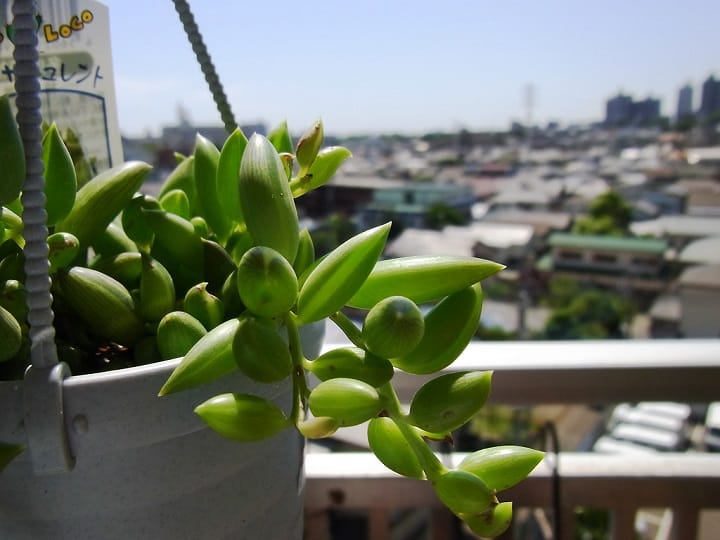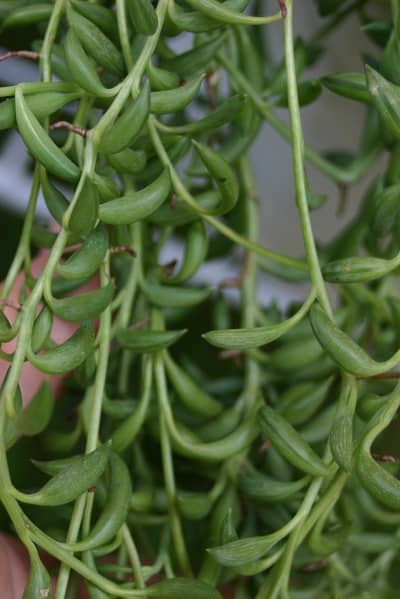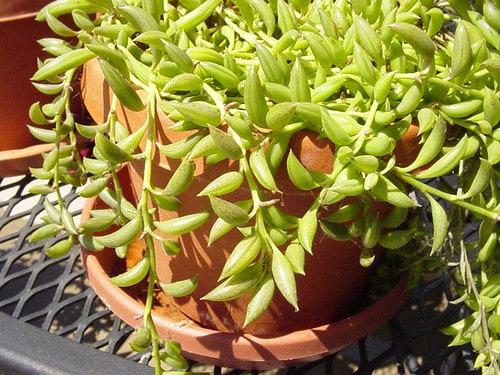Beginner’s Guide to Propagating String of Bananas
Got a String of Bananas plant swinging from your ceiling? Awesome! These leafy friends look cool, but keeping them happy can be a bit tricky—they really don’t like too much water. As long as you keep them from getting soggy, they’ll be your long-time green buddies. Ready to make more of these funky plants? Let’s get right to it and learn how to multiply your String of Bananas in just five minutes!

Say hello to the String of Bananas—no need to remember the mouthful ‘Senecio radicans.’ It’s just like its cousins, the heart-charming String of Hearts and the quirky String of Pearls, a real standout in the plant world.
Guess what? You can easily grow more Strings of Bananas yourself! It’s a breeze, truly something anyone can tackle. A bit of waiting is the hardest part, but in no time, you’ll see tiny roots poking out. Grab your scissors and a place to pop your cutting—a cup of water or a pot with some fresh, dry soil for succulents, and you’re good to go.
Here’s a list of what you will need:
- Your very own String of Bananas plant
- A trusty pair of scissors
- Some disinfectant (because clean cuts mean happy plants)
- A glass jar with water or a flower pot with special soil for succulents
Contents
- 1 How to Propagate String of Bananas
- 2 Frequently Asked Questions
- 2.1 Can you propagate string of bananas plant in water?
- 2.2 Can you propagate string of bananas from a leaf?
- 2.3 Does string of bananas need direct sunlight?
- 2.4 Does string of bananas grow fast?
- 2.5 What soil is good for string of bananas?
- 2.6 Does string of bananas need succulent soil?
- 2.7 Why is my string of bananas not plump?
How to Propagate String of Bananas
Mastering the string of bananas propagation is straightforward. Just follow the steps below.
Step 1: Pick Your Propagation Method
You’ve got two paths to more plants: water or soil. Before you snip anything, decide which route you’re taking. It’ll shape your whole game plan.
Don’t forget to start with squeaky-clean scissors. Wipe them down with rubbing alcohol or a disinfectant to keep your plants healthy.
Step 2: Snip Snip! Cut Your Cuttings

With your scissors all set, it’s time to choose the perfect bit of plant to start a new one. Aim for a stem that’s at least 4 inches long.
Grab one or more at once—it’s up to you. Just remember, you need to clip the stem long enough to ditch the bottom ‘bananas’ while still keeping a couple at the top.
Step 3: In Water or In Soil—Plant Your Future Plant
If you’re looking to expand your collection, Curio radicans propagation can be accomplished through two primary methods—water and soil.
Now, if you chose water, drop those stems in a jar—just ensure the lowest ‘bananas’ don’t touch the water. If they do, snip them off.
Going with soil? Same thing—remove the bottom ‘bananas,’ and then stick the stem in or lay it on top of the soil, cut side down. For those interested in banana succulent propagation through soil, this approach often leads to stronger root systems from the outset.
Step 4: Sit Tight and Watch for Roots
With soil cuttings, keep the watering light. Let the soil get dry before you water again.
Roots will start where you cut off the ‘bananas.’ Water babies will show roots first, but soil kiddos are less work. Give it about a month, and then, with roots ready, move any water-grown sprouts into their new soil homes.
Time to get your plant parent mode on and see the magic happen as baby Strings of Bananas come to life!
Frequently Asked Questions
Can you propagate string of bananas plant in water?
Yes, you can propagate this plant in water. In fact, propagating string of bananas in water is a popular method for beginners. Simply use a cutting from a robust, mature plant, about three inches long with a few leaves, and submerge it in water. Change the water regularly to maintain its cleanliness. After the cutting develops roots, you can transplant it into soil composed of peat, sand, and perlite, ensuring the soil stays moist but not waterlogged, and provide plenty of indirect sunlight. With attentive care, the cutting will begin to grow and eventually form a mature plant.
Can you propagate string of bananas from a leaf?
Indeed, leaf propagation is possible, albeit more challenging than stem propagation. Detach a healthy leaf and place it on top of a potting mix, keeping the soil slightly moist. The leaf requires a consistently warm, humid environment to root successfully.
Does string of bananas need direct sunlight?

Direct sunlight is unnecessary and can be harmful to the String of Bananas plant. It thrives in bright, indirect sunlight; too much direct light can damage the leaves. A location with filtered light, such as near a south- or east-facing window, is ideal.
Does string of bananas grow fast?
The String of Bananas is known for its rapid growth, particularly when in well-drained, nutrient-rich soil. It can reach lengths of 1 to 2 feet and produce numerous stems with distinctive, banana-shaped leaves.
What soil is good for string of bananas?
A well-draining, succulent-friendly soil mix is best—incorporate one part potting soil, one part coarse sand, and one part perlite or pumice. This soil composition promotes healthy root growth and prevents moisture from becoming stagnant, offering the necessary aeration for the plant to flourish.
Does string of bananas need succulent soil?
Given that this plant is a succulent, it requires well-draining soil. Succulent soil is designed to facilitate proper drainage and prevent root rot, with a mix of sandy and loamy soils, complemented by organic matter such as compost or coco coir. While a proprietary succulent mix is optimal, an amended generic potting soil with sand and perlite can also work effectively.
Why is my string of bananas not plump?
A lack of plumpness in the String of Bananas may indicate inadequate light, overwatering, or insufficient nutrients. To remedy this, position the plant in an area with bright, indirect light. Allow the soil to dry between waterings and furnish the plant with a monthly dose of balanced liquid fertilizer. For encouragement of new, fuller growth, prune any elongated stems.”
